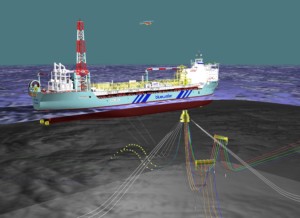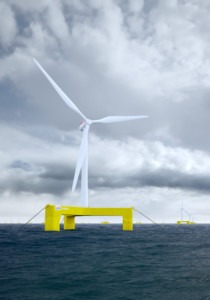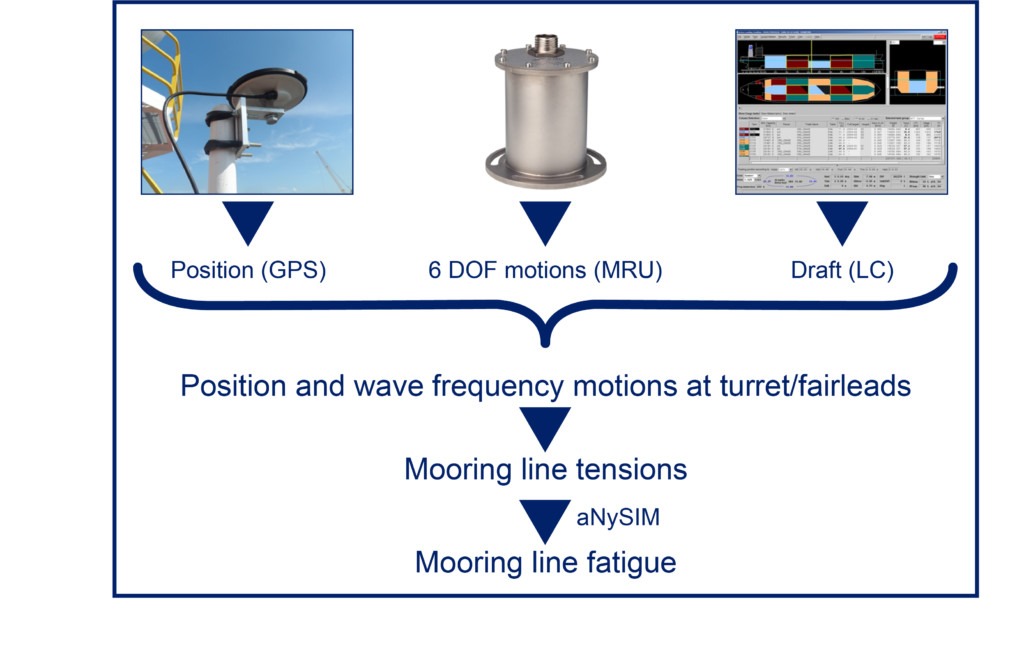Following the successful implementation of fatigue design tools for onboard Advisory Hull Monitoring Systems (AHMS), mooring simulation software aNySIM is being integrated into an onboard fatigue tool for the integrity management of mooring lines.
AHMS advises on the hull integrity of FPSOs and helps the owner to understand the real age of the vessel by monitoring fatigue loading and coupling it back to the design tools. AHMS not only measures the fatigue but also explains why the measured fatigue deviates from design predictions. For this purpose the design tools are integrated into the software and are ‘brought onboard’ the FPSO, which is rather unique in the industry. Using this method all the processing occurs automatically onboard of the FPSO.
AokaMizu FPSO Courtesy Bluewater
In July, MARIN successfully installed a prototype fatigue advisory software for the moorings of the Moho Nord FPU. The software processes the load cell measurements from the Tension Monitoring System and explains any differences with design predictions. Differences may originate from different conditions (environmental and loading) assumed during the design process or from shortcomings in the fatigue design tool.
Tri-Floater Courtesy GustoMSC
Onboard time domain simulation program aNySIM
The advisory software for the moorings addressed above requires tension measurements from the mooring lines, which can be a serious disadvantage. First of all because the majority of the existing floating production systems do not have a monitoring system installed with strain sensors on the hull or tension sensors in the mooring lines. Secondly, when these sensors have been installed a number of them are often malfunctioning. Repairing the sensors is costly and may have an impact on the operational activities onboard. Replacing a sensor in the mooring line may even require temporary disconnection of the mooring line (in the case of direct tension monitoring). Implementation of an advisory software, which requires input from hull strain and mooring tensions onboard of existing floating productions systems, is therefore difficult.
Due to these issues MARIN has started the development of an onboard software for the integrity management of mooring lines without the need of sensors in or on the mooring line itself. Mooring line fatigue is dominated by ship’s motions at the fairlead positions. With the time domain simulation program aNySIM the mooring line tensions are calculated using the ship motions, the horizontal turret position in the field and the draught of the FPSO as input. For shallow water applications particularly the draught of the FPSO will affect the tension loads in the mooring lines. The calculated tension loads are input for mooring line fatigue calculations. Using this software running onboard the FPSO, operators are given real-time advice with respect to fatigue accumulation in the mooring lines without the need for underwater sensors.
The horizontal turret position of the FPSO, required for the onboard fatigue integrity management tool for mooring lines, can be obtained from a Turret Position Monitoring Systems.
Turret Position Monitoring Systems (TPMS)
Timely and adequate warnings of mooring failures remain an important operational requirement in the offshore industry. Warnings of mooring line failures are provided by TPMS developed by MARIN and have been applied to numerous projects. These GPS-based systems comprise a highly accurate, long base, dual antennae system installed on the wheelhouse outside hazardous areas.
TPMS is being further developed in the LifeLine JIP. A methodology of a mooring failure alarm system based on offset position monitoring and advanced signal processing is being developed. The methodology will be implemented in an onboard software tool that processes the measurements onboard and provides an alarm in case a mooring failure is suspected. These developments will be accompanied by model tests and in service tests onboard a floating production system.




